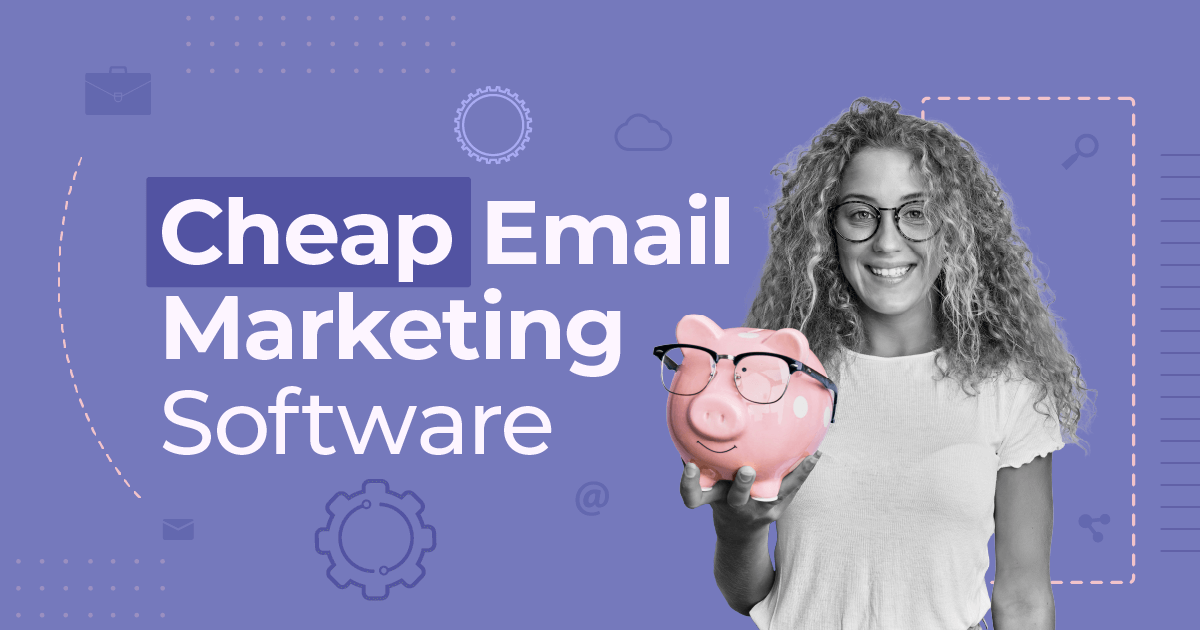
26 Tested Email Marketing Best Practices That Drive Results [2025 Update]
Just getting started with email marketing and not sure how to take it to the next level?
You’re in the right place. In this guide, we dive into proven email marketing best practices designed to help you grow your business with confidence.
From crafting irresistible subject lines to launching standout seasonal campaigns, these tips will help you connect with your audience through your email channel and keep them coming back for more.
Put email best practices to work
Access powerful and flexible email marketing features from $9/month.
Start free1. Lead with Valuable Content
Reciprocity—giving value back to your audience—is one of the core principles of building a strong and profitable relationship with prospects and clients. To achieve this, you need to adopt customer-centric practices that will nurture them into brand advocates.
Start by asking yourself: Who is your target audience? Your ideal customer profile (ICP) will reveal what your customers and prospects want, helping you address their pain points. Knowing who to target allows you to design a content marketing strategy that benefits your audience and maximizes your email marketing efforts.
There are many ways to add value to your email messages:
- Provide case studies and success stories for inspiration.
- Offer recipes, DIY guides, and other tips that aren’t product specific.
- Show them educational product content (blog posts, ebooks, etc.) that addresses their pain points.
- Give them freebies, discounts, giveaways, and so on.
Here’s a great example from ROCC offering subscribers a free product to entice them:

If you are constantly spamming your prospects with sales emails just to boost conversions, you will quickly lose subscribers and reduce your chances of making the sale. Instead, focus on building long-term relationships with your audience to boost customer acquisition and retention.
2. Send Your Emails at the Right Time
One of the most frequently asked questions out there is: “When and how often should I send out emails?”
To answer this question, let’s look at some data:
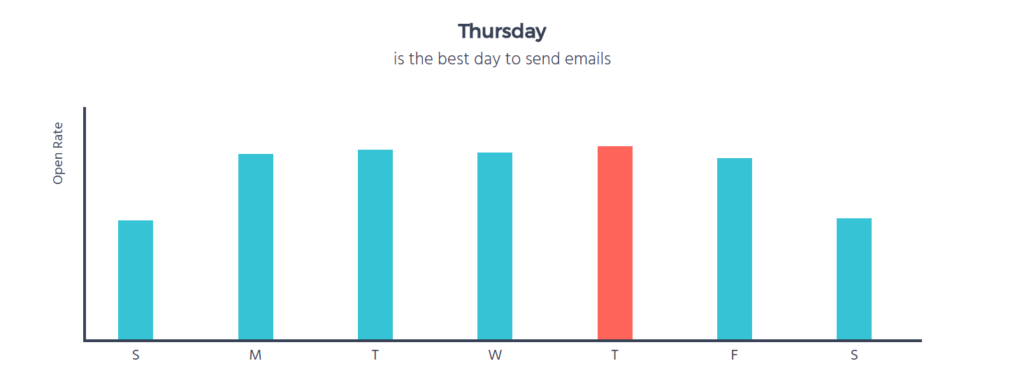
- Emails delivered on Thursdays had the highest open rate, followed by Tuesdays.
- Saturday had the lowest average open rate.
- Email open rates were the highest between 8 am and 9 am.
- After 6 pm, the open rates started to decline.
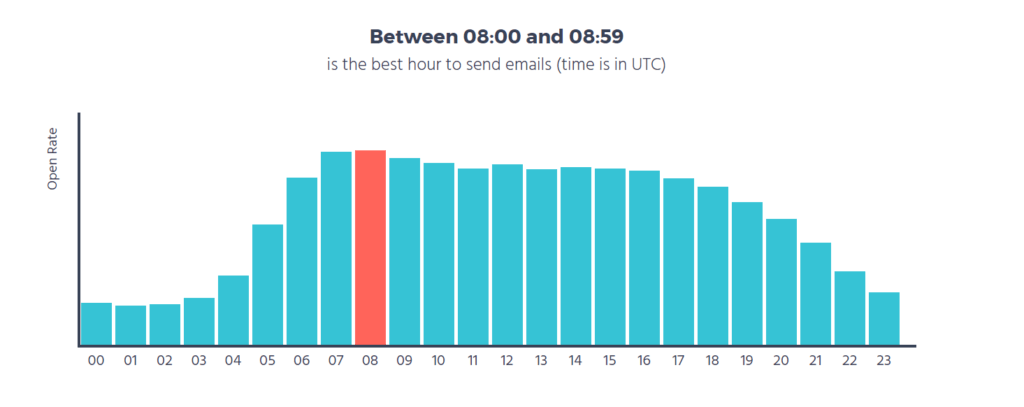
As for frequency, the optimum number for getting your emails opened is 2-5 campaigns per month. However, this doesn’t necessarily mean this will be right for your email list. The more you learn about your prospects’ behavior, the easier it will be to determine the best timing and frequency of your email campaigns.
In the beginning, it’s best to experiment and deliver your emails at different times to figure out what works. This way, you can minimize the chance of your campaigns ending up in your subscribers’ spam folder or trash.
3. Target the Holiday Season
Sending holiday campaigns should be a key part of a successful email marketing strategy, especially in eCommerce. When you think of the holiday season, you automatically think of Halloween, Black Friday, and Christmas. However, these aren’t the only festive times of the year.
Here are some additional holidays you can target:
- Labor Day (First Monday in September)
- Octoberfest (September-October)
- Hannukah (November-December)
- Lunar New Year (January or February)
- Carnival/Mardi Gras (February or March)
- St Patricks’ Day (March 17)
- US Independence Day (July 4)
Using the power of customer data, you can create specific segments for people celebrating different holidays. For example, if you have customers in the US, target this audience segment with Fourth of July messages.
To plan ahead, use email marketing software like Moosend or Constant Contact to automate parts of your strategy and save time. Grab a customizable, mobile-friendly email template to design your holiday campaign and set up automation workflows to send time-sensitive content to subscribers.
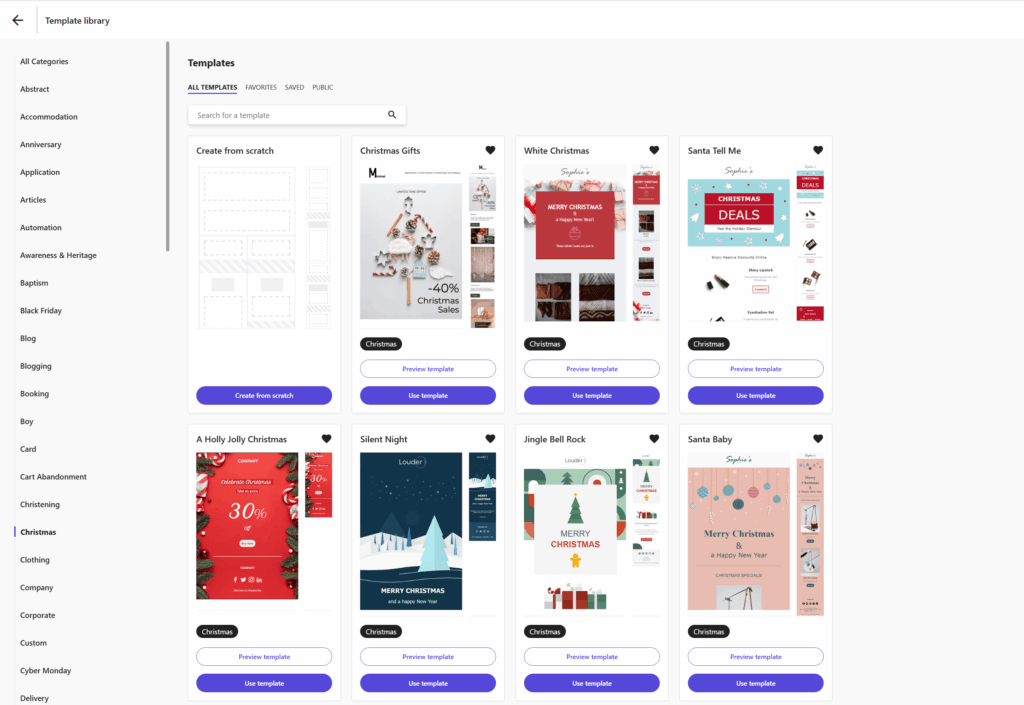
4. Write Clear and Compelling Subject lines
Paying attention to your subject line copy will help you get your message in front of the right people, prevent campaigns from landing in the spam folder, and ultimately increase your open rates.
To make readers open your emails:
- Add a sense of urgency/scarcity: Use actionable language that tells readers why they should act quickly.
- Make them short and sweet: Aim for 30 to 50 characters (including spaces) to ensure that your prospects will read them without getting cut off, particularly by mobile devices.
- Remove spam triggers: Avoid all caps and multiple exclamation points or spammy words like Cash, Buy now, or Save to protect your email deliverability.
- Use emojis: A clever emoji will help your email subject line stand out in the inbox. For instance, the majority of Halloween subject line examples include pumpkin or ghost emojis to be playful and creative.
- Spark curiosity: Provide enough information to hook your audience and make them curious, without satisfying that anticipation until they click.
If finding the best subject line for your email is challenging, use an AI writer to test how they perform. You can also get valuable suggestions on how to improve them, like adding personalization or emojis.
5. Hyper-Personalize Your Content
You’ve probably heard about email personalization. A simple practice to start with is adding your subscriber’s name in the subject line or email copy. However, to hyper-personalize your campaigns, one of the best tactics is tailoring your messages to your audience’s needs.
The more you know about your recipients, the better your campaigns will be. Combine the power of data, consumer insights, analytics, and automation. As a result, your message will feel less salesy and more natural, providing an instant solution to your customers’ pain points.
For example, BareMinerals often uses this practice in the form of a “We saw you looking” campaign. These automated messages leverage online behavior to target users with the right content, at the right time:
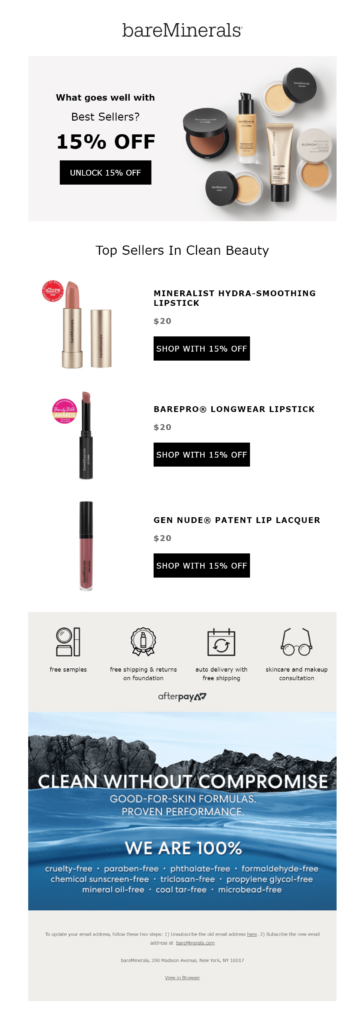
To achieve this, you’ll need the help of a marketing automation tool like Moosend or Mailchimp to set up smart workflows that will leverage the power of data.
6. Automate Your Email Campaigns
Setting up automated email workflows not only saves you time but also allows you to personalize and segment your list based on predefined rules or triggers.
Some examples of successful email automation include:
Welcome Emails: Engage new subscribers with a welcome email to take advantage of the excitement and curiosity of new email subscribers.
Re-engagement emails: These are sent to inactive customers or subscribers who haven’t engaged in your emails for a certain amount of time to re-engage them with your brand.
Milestone emails: These emails celebrate key moments throughout a customer’s journey, such as anniversaries or birthdays. You can also include a discount or freebie with an expiration date to create urgency and increase click-through rates.
Check out this welcome email by Moment:

You can also set automated email sequences, also known as drip campaigns, to send timely emails to subscribers. Onboarding is a popular example. You can launch a sequence of emails with different incentives to welcome new customers and set them up for success.
7. Improve Your Email Through A/B testing
A/B, or split, tests can help see what strategies and offers work best for your business. A/B testing involves testing two different variations of the same campaign to see which one gets the best results. The first step in setting up an effective process is to decide what you’ll test.
While you may want to check more than one element, it’s important to test only one thing at a time. By isolating a single variable, you can more easily understand why one email performed better than the other.
Email elements to test include:
- Subject lines – Test different phrasing or offers to see what gets more clicks.
- Calls-to-action – For example: “Buy Now!” vs. “See Plans & Pricing.”
- Sending time – Are your readers more likely to open an email sent at 7:00 am on a Tuesday or 6:00 pm on a Friday?
- Email content – Try out various images and copywriting styles.
- Personalization – Use or remove the sender’s name in the subject line.
- Special offers – For example, “Save 20%” vs. “Get free shipping.”
Overall, optimizing your emails is one of the most important email marketing best practices. Be open to change and make adjustments to increase engagement and profit.
8. Come Up with Engaging Email Copy
Aside from being valuable and concise, email copy should also be interesting and entertaining. Depending on your audience, try to incorporate your brand tone and give your recipients a unique experience.
While the main goal is leading people towards your call-to-action (CTA), you need to capture readers’ attention and make them want to engage with your content and brand long-term.
Successful brands like Coca Cola use storytelling to establish a strong bond with their customers. This, in turn, results in increased loyalty, better engagement rates, and most importantly, trust. These stories can be personal, funny, and highly relatable to your audience, helping to humanize a brand.
For instance, Blizzard is a gaming company that uses story-infused email copy to convey various marketing and sales messages to its audience.
Let’s look at this example:

For Blizzard’s subscribers, this copy is on-point and relevant, offering readers an immersive experience beyond just their favorite game.
9. Design Visually Appealing Emails
“A picture is worth a thousand words,” they say, and that applies to emails, too. Add high-quality, relevant visuals that align with your brand style to delight subscribers. Plus, make sure that your CTA buttons stand out from the rest of the text to boost open rates.
Check this amazing example by Surreal, and see how they used their brand colors, product image, and overall style to entice subscribers:

Most email marketing tools offer premade templates to easily design your campaigns. Grab a template and customize it with your content to save time. Upload images, videos, or GIFs to create an amazing experience. Ensure that these templates are responsive, so they’ll look good on several mobile devices and email clients.
Finally, include ALT text in your images to make your emails accessible. Use plenty of white space and clean layouts to ensure maximum readability.
10. Optimize the Preview Text
Your preview text can complement your subject lines. Use it to provide more details that support your message and boost your engagement metrics.
Let’s look at some examples:

Wendell August Forge uses its preview text to give subscribers an extra incentive to interact with the email campaign. The brand’s choice is clever, as it reinforces the new product launch.
Similarly, Elementor grabs the opportunity to show the value of checking the new email by telling subscribers about the new things they can do.
Overall, adding relevant preview text that supports your subject line is an excellent way to entice your recipients and boost open rates, without breaking the subject line length rule.
11. Build Your Own Email List
Sometimes people might approach you to sell you ready-made email lists. While it might sound tempting, avoid accepting such offers, as this practice doesn’t comply with GDPR guidelines
Lists like these often contain subscribers of questionable origin. They haven’t opted-in and might not be interested in what you offer. You’ll see many of them unsubscribing or moving you to spam the moment you start contacting them.
Creating your own list of engaged subscribers is far better than buying random mailing lists, even if the numbers are low at first. It’s time-consuming, but safe for your brand.
The best way to power up your list building efforts is to create converting sign-up forms and landing pages. Offer compelling incentives to web visitors to get their opt-in and start nurturing them with relevant content.
12. Segment Your Email Lists
Email marketers can create different customer segments based on their recipients’ demographics, lifestyle, location, website activity, job title, psychographics, and other factors. To make your messages effective, make this email marketing best practice a priority.
Here’s a great email example from Papier. The brand created a specific segment to deliver back-to-school product recommendations and a discount to students, making the offer as irresistible as possible to help them nail their assignments:

Segmentation ensures that people receive relevant deals and offers, making them more likely to buy and less likely to unsubscribe. You can also add a preference center to collect customer information during the sign-up process. Learn about their interests and email frequency preferences to refine your email segmentation tactics.
13. Clean Your Email Lists
High bounce rates and invalid email addresses can make your email marketing campaigns hit spam thresholds. To avoid that, it’s essential to clean your list regularly.
First, remove invalid emails, known as hard bounces. A hard bounce occurs when an email address doesn’t exist on the server. Removing those addresses can improve your sender reputation. Most email marketing software like Moosend lets you automate this process.
It’s important to track soft bounces, too. A soft bounce occurs when an inbox is full or temporarily unavailable. You might not want to remove those addresses right away, but if you’re consistently getting a soft bounce from the same email address, it’s probably time to say goodbye.
Finally, remove inactive email subscribers. How long should you wait? While there’s no definitive answer, a good rule of thumb is: if someone hasn’t opened any of your emails for a year, they are probably no longer interested.
14. Use a Double Opt-in
When a new subscriber signs up for your emails, you can send them a link to confirm the subscription. This process is called double opt-in.
While the double opt-in adds an extra step to your subscribers’ journey, it’s one of the safest email marketing best practices you need. If new subscribers end up on your list, it means that they’re genuinely interested in your brand and content, and that their email addresses are valid.
And if you’re worried this might slow down your list growth rate, remember that using double opt-in will positively impact email deliverability in the long term.
15. Let Your Audience Unsubscribe Easily
Let’s face it—not everyone who opts in to your email newsletter will want to stay on your list forever. People move away, change jobs, or simply lose interest.
Regardless of the reason, nothing is more frustrating for your subscribers than having to jump through hoops to unsubscribe from an email list, so give them an easy way out.
The most common place to add your unsubscribe button is at the bottom of your campaign. Sometimes, though, Gmail will display your unsubscribe link next to your sender address—like Happy Socks:
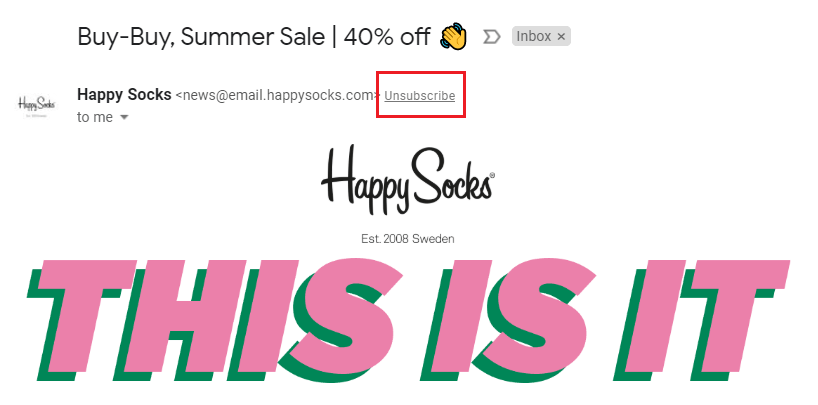
Alternatively, you can place the unsubscribe button at the end of your campaign during the email design. Avoid hiding it or using small fonts on purpose and ensure users don’t need to log back into their account to complete the process. Failing to do so may trigger spam reports and hurt your deliverability rates.
16. Avoid No-reply Sender Addresses
What’s the point in personalizing your email campaign or conducting A/B testing if your emails are sent from no-reply sender addresses? Blocking two-way communication can hurt your brand. Most importantly, you need to comply with the CAN-SPAM Act, which states that you shouldn’t use the words “no-reply” or anything similar in your sender name.
Use a legitimate sender address including your company name to build trust with your audience. Subscribers are also more likely to open your emails if they are written by a known contact.
Encourage subscribers to reply—collecting feedback is essential for your entire strategy. Increase the legitimacy of your emails by setting up DMARC. It lets you use your brand logo to support email clients as part of BIMI. This is an additional layer of authenticity to your email messages, establishing trust with your audience.
17. Instill a Sense of Urgency
There’s nothing like a bit of urgency to motivate consumers to head to checkout. Fear of missing out (FOMO) is a basic consumer instinct that marketers often tap into. Set a timeframe in which customers can take action, highlight the expiration date, and see an increase in click rates and conversions.
Begin by introducing urgency in your email subject lines:
- Our flash sale ends tonight
- Don’t miss our biggest sale of the year
- Sale ENDS today ⏳
- 🚨 Your last day to save 20% on everything! 🚨
Combining emojis and strong wording gives recipients an extra conversion boost. To increase your campaign effectiveness, you can also use countdown timers in emails.
Here is an example from Redbubble:
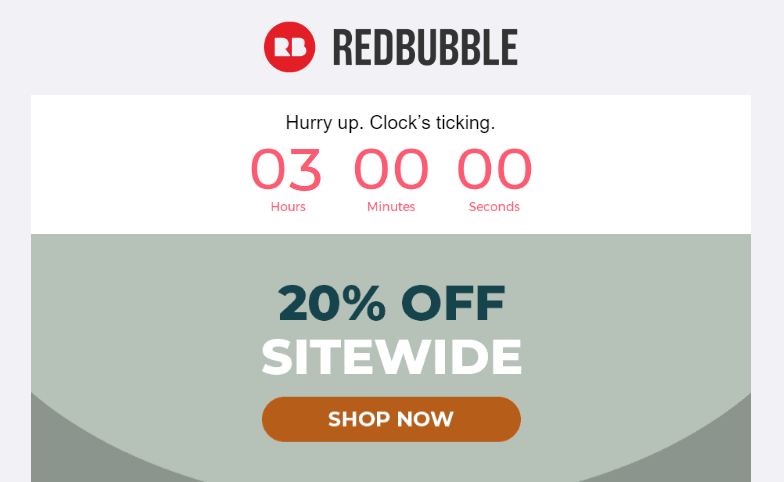
Want to add urgency to your next campaign? Sign up for a Moosend account, select a template from our library, and drag-and-drop a “Timer” element into it—simple as that.
18. Plan Social-Infused Emails
Gathering inspiration from social media is one thing, but using actual posts in your email campaigns is one of the most effective email marketing best practices to keep in mind. Integrating email and social media is one of the most popular tactics that email marketers use to increase engagement through channel cross-promotion.
Here, Fila created an email marketing campaign to promote its most-liked Instagram posts:

As you can see, the brand grabbed the opportunity to show their best content and use CTAs to lead their subscribers back to their product pages. That’s a smart way to boost your conversion rate.
Plus, you can always add social media buttons at the bottom of your emails and let your cross-promotional efforts run on autopilot.
19. Reward Customer Loyalty
Retaining existing customers is a lot cheaper than acquiring new ones. That’s why it’s important to keep your loyal customers satisfied with nurturing emails and meaningful incentives.
For eCommerce businesses, this can be done through customer loyalty emails or buyer appreciation campaigns. There are various ways to do this, such as sharing discounts or giving early access to exclusive products and services.
Some businesses also run customer reward points programs. This is, of course, a great way to retain loyal buyers and incentivize them to stick around.
Here’s an email example from Michael Kors, sent to subscribers who joined its loyalty program:
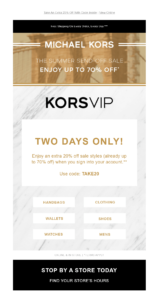
20. Equip Your Emails with Interactive Elements
When we talk about interactive emails, we’re referring to campaigns that include various elements recipients can engage with by clicking, hovering, or tapping inside the emails. These functional elements are designed to entice your audience by adding an extra layer of engagement that nudges recipients toward your CTAs.
Here’s an example from the Google store: recipients can choose a color and go straight to the checkout:

Since interactive emails require coding expertise to set up which is not supported by all email service providers, most marketers choose creative alternatives to keep the fun without draining resources. Static quizzes, videos, and GIFs are great options.
21. Take Care of Email Deliverability
Email deliverability refers to a set of activities that help ensure your email campaigns land in your subscribers’ inboxes. To maintain a high delivery score, you need to build and maintain a strong sender reputation.
Sadly, this score can be affected by a variety of factors. Some of them include:
- Unclean email lists
- Soft and hard bounces
- Spam filters or complaints
- Getting blacklisted
- Unsubscribe rates
To protect your deliverability, maintain good email list hygiene by regularly removing potentially harmful or inactive email addresses. Use a series of verification methods to confirm your Sender IP and email messages. Lastly, don’t hesitate to use email spam checking software to ensure that your email delivery and sender reputation remain intact.
22. Collect Customer Feedback
Collecting feedback on products and services helps you make optimizations more effectively. Thankfully, you don’t have to go to great lengths to find out what your customers think.
The only thing you need is a customer survey email. You can send different email versions to first-time customers to learn what they think of your brand or existing shoppers for more in-depth insights. Whatever you choose, don’t forget to give your audience the right incentive to take part in your survey.
Here, Grind created a dedicated email campaign to encourage recipients to share their experiences. Of course, participants have the chance to win a coffee machine:
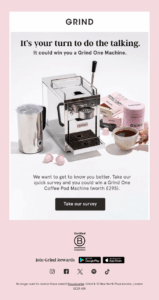
23. Match Your Emails with Your Landing Pages
Most of your email campaigns will probably lead your subscribers to your website or product pages. But what happens when they end up on your landing pages?
Since these are standalone assets, you can create converting landing pages that match your email campaigns to provide your audience with a sense of continuity. To achieve that effect, you can:
- Choose a similar design (colors, visuals, etc.)
- Maintain your tone
- Use similar wording and phrases
Here’s an email marketing campaign we worked on, showing how aligned designs, colors, and visuals can offer a seamless experience:
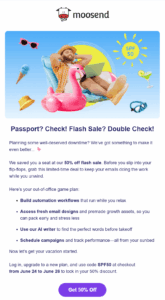
And here’s a section of the landing page design that subscribers see when they click the CTA:
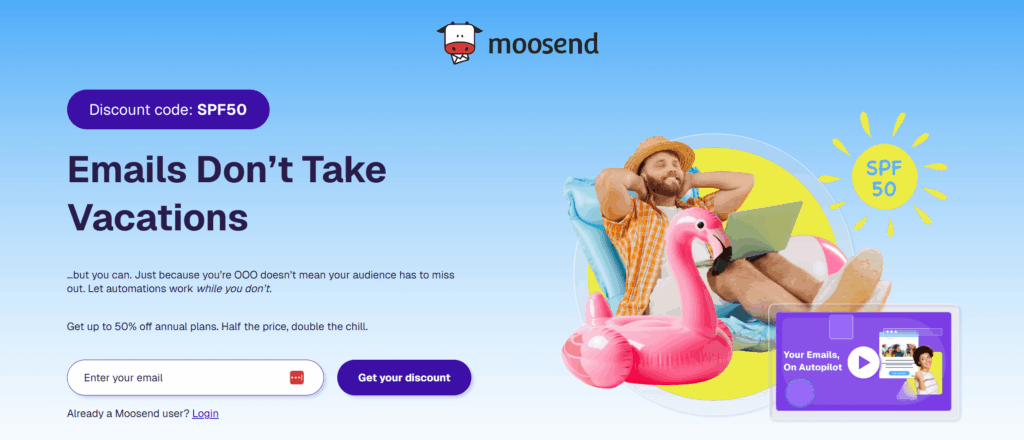
As for layouts, you can take advantage of email service providers offering matching landing pages and email newsletter layouts. For instance, Moosend’s landing page editor allows users to choose designs that look like their newsletter templates.
24. Pass the ‘5-Second Test’
Anyone creating email campaigns needs to remember that they only have a moment to capture their audience’s attention.
Your prospects are constantly bombarded with content every single day. It’s easy for them to tune you out. So, if something doesn’t capture their attention at once, it likely won’t catch it at all.
The 5-second test is a user research tool that helps marketers measure what information their audience takes away within the first five seconds of viewing a design.
First impressions matter and those five seconds may be all the time you have to get your point across. Send a copy of the email to a friend or colleague and ask them the following questions:
- What do you think this email is about?
- Is the product or service clearly presented?
- What do you remember most vividly?
If their answers don’t satisfy you or if they can’t see the point, then it may be time to go back and improve your email.
25. Measure Your Results
With the amount of data available to businesses today, it’s easier than ever to monitor the performance of your email marketing campaigns using specific metrics. Most email marketing tools will automatically track this information for each campaign you set up.
These key email marketing metrics can provide insight into what content resonates with your audience. Without measuring these data points, it’s impossible to improve your results:
Open rate: It shows how many people open your emails. If your open rate is low, you likely have a lot of disengaged subscribers, or your subject lines aren’t capturing their interest.
Click-through rate (CTR): The percentage of people who click on your call-to-action. If your CTR is low, it means that your message is either not relevant enough or simply not getting through. To fix this, focus on improving your copywriting skills and segmentation.
Unsubscribes: Measure the number of contacts who unsubscribe from your list after receiving a campaign from you. If you unsubscribe rate is high, analyze when and why people leave and act based on those insights.
26. Set Up RSS Campaigns
RSS campaigns are automated messages sent to subscribers every time new content is published on your blog.
These emails are perfect for increasing your organic traffic (and supporting your SEO efforts) by promoting them directly to your audience. To create these email campaigns, set them up through your email marketing software by selecting the RSS type and adding a feed URL.
Overall, RSS campaigns are an effective way to drive engagement with your content and give your audience the latest updates without searching through your website.
5 Email Marketing Tools to Get You Started
Whether you’re just getting started with email marketing or you’re already a seasoned marketer, using the right email marketing software for your business can save you time and make your emails pop.
The best email marketing software should allow you to design emails easily, segment your list, personalize your messaging, create automation workflows, and view analytics reports. So, let’s take a look at some of the most popular email marketing services and how they stack up against each other.
1. Moosend
Moosend is an email marketing and marketing automation platform that offers various features at an affordable price.
You can easily create a campaign from scratch in a few minutes using the drag-n-drop email builder or select one of the available pre-made newsletter templates to save time and effort.
Features
- Easy-to-set-up automated workflows
- Personalization features to deliver targeted content
- Email list segmentation to group your audience more effectively
- Landing pages and online form builder to boost your lead generation
- Real-time reporting and analytics to monitor your performance
- Integrations to connect your apps and increase your productivity
Pricing: You can sign up for a free trial to test everything out, including the landing page and form builders. Paid plans start at $9/month, giving you access to unlimited forms and landing pages, transactional emails, reporting, and more.
2. Constant Contact
Constant Contact is an easy-to-use and beginner-friendly tool that lets SMBs create emails and online forms for their audiences.
Features
- Simple automated workflows based on behavioral data
- Advanced event invitations management tool
- Easy-to-use autoresponders
- Email tracking feature to monitor performance
- Integrations for social media and eCommerce platforms
Pricing: The software offers a 14-day free trial. Paid plans start at $12/month.
3. HubSpot
HubSpot is one of the leading marketing automation software products known for its powerful customer relationship management (CRM) capabilities that make personalization and segmentation simple.
Features
- Multi-step marketing workflows
- CRM capabilities for lead management
- Landing page builder
- A/B testing capabilities
- Predictive lead scoring options
Pricing: Free plan, paid plans start at $15 per month.
4. Mailchimp
Mailchimp is one of the top email marketing platforms on the market, known for its multi-step custom workflows and advanced A/B testing capabilities.
Features
- Advanced segmentation and behavioral targeting
- Landing pages to increase your lead generation impact
- Variety of integrations with popular apps
- 300+ integrations that help you customize the tool to your business.
Pricing: Mailchimp has a limited free plan. For extra tools, pricing starts at $13/month.
5. Brevo
Brevo is an email service that offers users the ability to integrate their email marketing with SMS marketing, create landing pages, and send transactional emails.
Features
- SMS autoresponder
- Landing page builder capabilities
- A/B testing
- Pre-made automation campaigns
Pricing: Available free plan. For more, paid plans start at $9/month.
Email Marketing Tips to Help You Succeed
Getting started with email marketing might seem overwhelming, but it doesn’t have to be. Ensuring that you have a strong plan in place along with the right tools and support can take you from zero to hero.
And while these email marketing best practices are enough to get you started, don’t forget to blend email with other digital marketing practices, including social media, to nurture your target audience through multiple touchpoints.
FAQs
Let’s explore some frequently asked questions about our topic:
1. What are the 5 T’s in email marketing?
The 5 T’s in email marketing refer to Targeting, Timing, Tailoring, Testing, and Tracking—the requirements for an effective email marketing strategy.
2. What is the 80/20 rule in email marketing?
The 80/20 email marketing rule means that 80% of your campaign should aim at providing value while 20% can focus on direct promotions and sales.
3. What are the 5 P’s of email marketing?
The 5 P’s of email marketing mean Product (what you offer), Price (the perceived value of the product or service), Place (the email channel and list), and Promotion (the benefits of your offers).
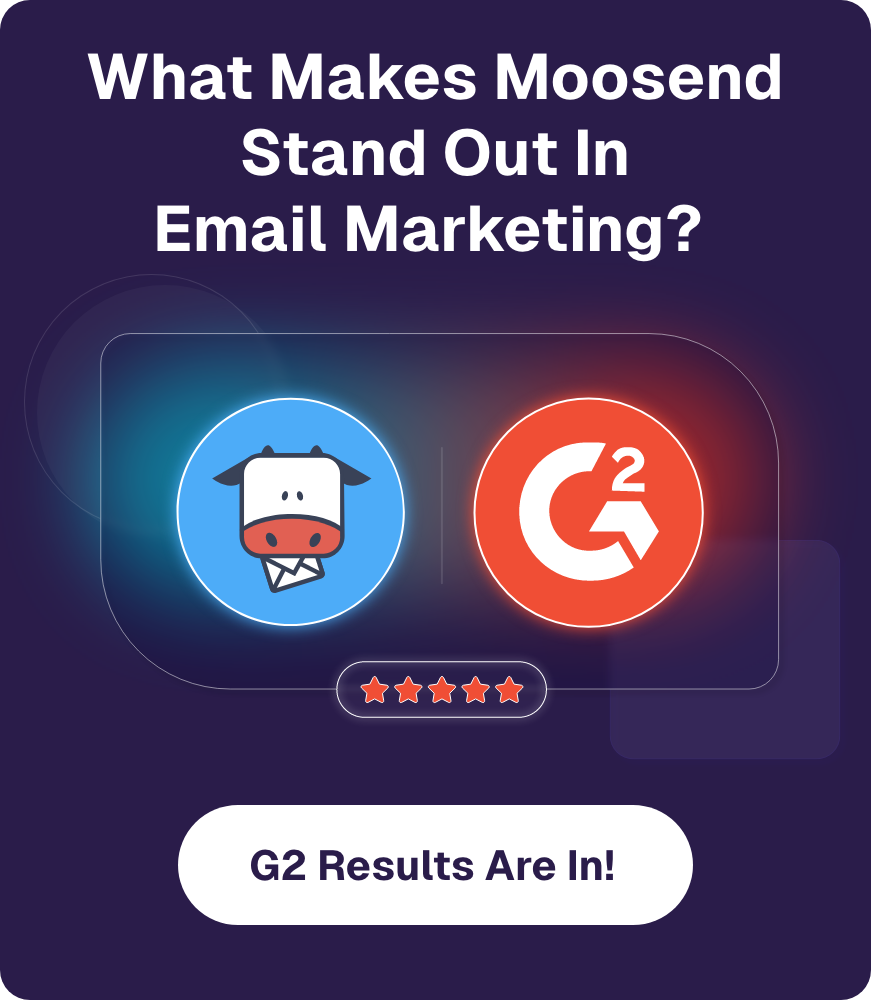

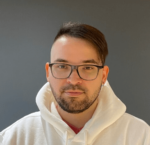

 Published by
Published by
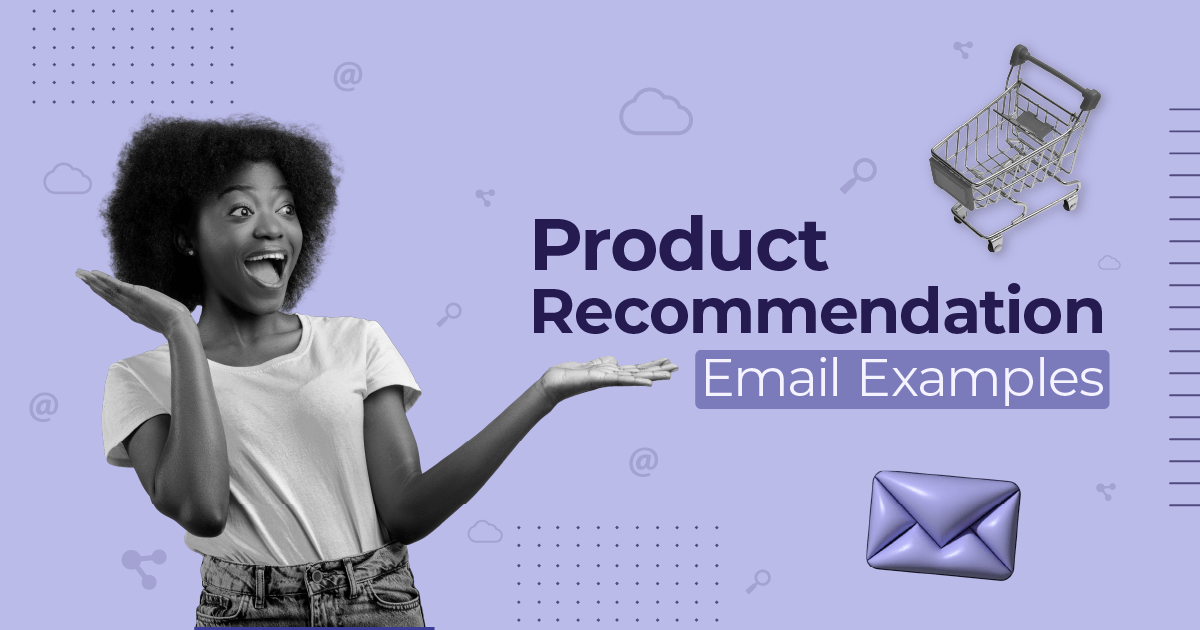
 Published by
Published by
